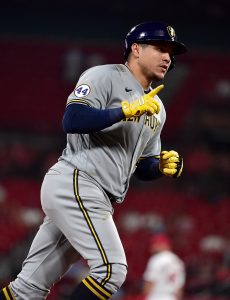Amed Rosario found his swing in August. The Indians shortstop slashed .372/.397/.584 in 121 plate appearances across 26 games in August. That effort buoyed his overall line to .288/.327/.422, two percent better than average by measure of wRC+. Among qualified shortstops, Rosario ranks 13th in the Majors, firmly between Javier Baez and Nicky Lopez. Both Baez and Lopez are considered plus defenders, however, while the jury is still out on Rosario (-8 DRS, 1.4 UZR,-1 OAA in 876 innings).
In fact, there’s question as to whether Rosario will be a shortstop at all next season, writes Ryan Lewis of the Akron Beacon Journal. The uncertainty is driven not so much by his glovework, however, but because of Andres Gimenez, whose defensive prowess makes him a better long-term fit for the position. Gimenez has yet to hit for the Indians, but he tore up Triple-A with a .287/.342/.502 line. Still just 22-years-old, the Indians hope that he can seize shortstop as his own next season. If that happens, Rosario could be expendable.
When played together, Cleveland has put Gimenez at the keystone, though that doesn’t seem to be the long-term plan. That might speak to an uneasiness about playing Rosario at second, or it could be that they’d just rather keep the consistency of Rosario at short for this season. In theory, Rosario could have a future at second, but we haven’t seen him play there yet, and Lewis suggests he’s more likely to be utilized in the outfield.
Rosario’s development at the plate, therefore, hasn’t solidified Cleveland’s shortstop picture, but it does provide the organization with the one thing every front office wants these days: flexibility. Rosario could well be used at shortstop, but he could also return to the outfield or even be used as trade bait, Lewis notes.
If he does go back to the grass, it’s more likely to be in one of the corners than in center. Myles Straw has stabilized center, allowing Rosario to slide to a corner to potentially cover for Josh Naylor until he’s healthy enough to return. Rosario spent 123 1/3 innings in center this year, not enough of a sample to make a decision about his defensive ability there, but enough to grant credence to the idea of Rosario as a supersub.
The concern would be that Rosario’s bat doesn’t yet play as a plus in an outfield corner. That said, the depth at shortstop league-wide is such that the positions aren’t as far apart as in the past. By wRC+, Rosario would rank 18th among right fielders with at least 400 plate appearances, or 14th among left fielders – suggesting that Rosario could be a passable option in a corner.
He certainly could have a role as a supersub who plays everyday, but he might bring more value to a club who wants to install him as their everyday shortstop. He has two years of team control remaining, which adds to his appeal.
What happens next might depend on how the 25-year-old finishes the season. Cleveland has time to figure this out, but if Rosario has finally established himself as an everyday regular, the rest is gravy. Now they just have to figure out what to do with him. Can we point them in the right direction?
(poll link for app users)

